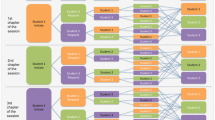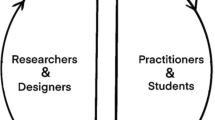Abstract
Complex adaptive systems theory served as a framework for this qualitative study exploring the process of how meaning emerges from the collective interactions of individuals in a synchronous online discussion through their shared words about a topic. In an effort to bridge levels of analysis from the individual to the small group to the community, we analyzed how a group of students introduced, sustained, and eventually let go of one topic while participating in a classroom discussion that took place in a CSCL environment. Our purpose was to examine a single posted message’s influence not only through the responses it garnered, but also by how individuals reacted to it intellectually. Participants were eight students and their teacher in a graduate-level seminar. Data sources included the online discussion’s final transcript, screen-captured recordings of each participant’s computer screen, video recordings of participants’ actions, and observation notes. Our analyses revealed three key understandings: (a) the interdependencies of process and content are manifestations of the complex development of co-created understandings in computer-supported discussions, (b) private individual processes and particular meanings co-mingle in a social space to create publicly shared experiences, and (c) the importance of attending to the content was shown in the details of a topic’s incipience, its developing “mid-life,” and how factors conspired to its end. These findings help illustrate how co-created meaning-making experiences emerge in a system through interactions among individual agents, suggesting ways instructors may work to foster student learning in CSCL contexts.

Similar content being viewed by others
Explore related subjects
Discover the latest articles, news and stories from top researchers in related subjects.References
Anderson, R. C., Nguyen-Jahiel, K., McNurlen, B., Archodidou, A., Kim, S., Reznitskaya, A., Tillmans, M., & Gilbert, L. (2001). The snowball phenomenon: Spread of ways of talking and ways of thinking across groups of children. Cognition & Instruction, 19, 1–46.
Atkinson, J. W. (1957). Motivational determinants of risk-taking behavior. Psychological Review, 64(6), 359–372.
Boyd, M. P., & Markarian, W. (2015). Dialogic teaching and dialogic stance: Moving beyond interactional form. Research in the Teaching of English, 49(3), 272–296.
Byrne, D., & Callaghan, G. (2014). Complexity theory and the social sciences. New York: Routledge.
Carver, C. S., & Scheier, M. (2002). Control processes and self-organization as complementary principles underlying behavior. Personality & Social Psychology Review, 6, 304–315.
Cho, B. Y. (2013). Adolescents' constructively responsive reading strategy use in a critical internet reading task. Reading Research Quarterly, 48(4), 329–332.
Cochran-Smith, M., Ell, F., Ludlow, L., Grudnoff, L., & Aitken, G. (2014). The challenge and promise of complexity theory for teacher education research. Teachers College Record, 116, 1–38.
Coiro, J., & Dobler, E. (2007). Exploring the online reading comprehension strategies used by sixth-grade skilled readers to search for and locate information on the internet. Reading Research Quarterly, 42(2), 214–257.
Cress, U., & Kimmerle, J. (2008). A systemic and cognitive view on collaborative knowledge building with wikis. International Journal of Computer-Supported Collaborative Learning, 3, 105–122. doi:10.1007/s11412-007-9035-z.
Cress, U., Stahl, G., Ludvigsen, S., & Law, N. (2015). The core features of CSCL: Social situation, collaborative knowledge processes and their design. International Journal of Computer-Supported Collaborative Learning, 10(2), 109–116. doi:10.1007/s11412-015-9214-2.
Erickson, F. (1999). Going for the zone: The social and cognitive ecology of teacher-student interaction in classroom conversations. In D. Hicks (Ed.), Discourse, learning, and schooling (pp. 29–62). New York: Cambridge University Press.
Evans, S. K., Pearce, K. E., Vitak, J., & Treem, J. W. (2016). Explicating affordance: A conceptual framework for understanding affordance in communication research. Journal of Computer-Mediated Communication. Doi:10.111/jcc4.12180.
Fleckenstein, K. S., Spinuzzi, C., Rickly, R. J., & Papper, C. (2008). The importance of harmony: An ecological metaphor for writing research. College Composition and Communication, 60(2), 388–419.
Galatzer-Levy, R. M. (2009). Finding your way through chaos, fractals, and other exotic mathematical objects: A guide for the perplexed. Journal of the American Psychoanalytic Association, 57(5), 1227–1249.
Halatchliyski, I., & Cress, U. (2014). How structure shapes dynamics: Knowledge development in Wikipedia – A network multilevel modeling approach. PloS One, 9(11), e111958.
Halatchliyski, I., Moskaliuk, J., Kimmerle, J., & Cress, U. (2014). Explaining authors’ contribution to pivotal artifacts during mass collaboration in the Wikipedia’s knowledge base. International Journal of Computer—Supported Collaborative Learning, 9, 97–115.
Hancock, J. T., Curry, L. E., Goorha, S., & Woodworth, M. (2008). On lying and being lied to: A linguistic analysis of deception in computer-mediated communication. Discourse Processes, 45(1), 1–23. doi:10.1080/01638530701739181.
Harney, O. M., Hogan, M. J., Broome, B., Hall, T., & Ryan, C. (2015). Investigating the effects of prompts on argumentation style, consensus and perceived efficacy in collaborative learning. International Journal of Computer-Supported Collaborative Learning, 10(4), 367–394. doi:10.1007/s11412-015-9223-1.
Hull, G. A., & Katz, M. L. (2006). Crafting an agentive self: Case studies of digital storytelling. Research in the Teaching of English, 41(1), 43–81.
Jacobson, M., Kapur, M., & Reimann, P. (2016). Conceptualizing debates in learning and educational research: Toward a complex systems conceptual framework of learning. Educational Psychologist, 51(2), 210–218. doi:10.1080/00461520.2016.1166963.
Jacobson, M., & Wilensky, U. (2006). Complex systems in education: Scientific and educational importance and implications for the learning sciences. Journal of the Learning Sciences, 15(1), 11–34. doi:10.1207/s15327809jls1501_4.
Jordan, M., Schallert, D. L., Cheng, A., Park, Y., Lee, H., Chen, Y., et al. (2007). Seeking self-organization in classroom computer-mediated discussion through a complex adaptive systems lens. National Reading Conference Yearbook, 56, 304–318.
Kapur, M. (2011). Temporality matters: Advancing a method for analyzing problem-solving processes in a computer-supported collaborative environment. Computer-Supported Collaborative Learning, 6, 39–56. doi:10.1007/s11412-011-9109-9.
Kapur, M., Voiklis, J., & Kinzer, C. (2008). Sensitivities to early exchange in synchronous computer-supported collaborative learning (CSCL) groups. Computers & Education, 51, 54–66.
Kimmerle, J., Moskaliuk, J., Oeberst, A., & Cress, U. (2015). Learning and collective knowledge construction with social media: A process-oriented perspective. Educational Psychologist, 50(2), 120–137.
Kincanon, E., & Powel, W. (1995). Chaotic analysis in psychology and psychoanalysis. The Journal of Psychology, 129(5), 495–504.
Koopmans, M., & Stamovlasis, D. (2016). Complex dynamical systems in education. Switzerland: Springer International Publishing. doi:10.1007/978-3-319-27577-2.
Kramsch, C. (Ed.). (2002). Language acquisition and language socialization: Ecological perspectives. New York: Continuum.
Larsen-Freeman, D. (1997). Chaos/complexity science and second language acquisition. Applied Linguistics, 18, 141–165.
Lee, S., Schallert, D. L., Song, K., Park, Y., Chiang, Y. V., Vogler, J. S., et al. (2011). Resistance phenomena in collaborative online discussions. Literacy Research Association Yearbook, 60, 370–388.
O’Connor, M. C., & Michaels, S. (1997). Shifting participant frameworks: Orchestrating thinking practices in group discussion. In D. Hicks (Ed.), Discourse, learning, and schooling (pp. 63–103). New York: Cambridge University Press.
O’Connor, M. C., & Michaels, S. (2007). When is dialogue ‘dialogic’? Human Development, 50(5), 275–285.
Op’t Eynde, P., & Turner, J. E. (2006). Focusing on the complexity of emotion-motivation issues in academic learning: A dynamical component systems approach. Educational Psychology Review, 18, 361–376.
Paulson, E. J. (2005). Viewing eye movements during reading through the lens of chaos theory: How reading is like the weather. Reading Research Quarterly, 40(3), 338–358.
Pennings, J. J. M., van Tartwijk, J., Wubbels, T., Claessens, L. C. A., van der Want, A. C., & Brekelmans, M. (2014). Real-time teacher-student interactions: A dynamic systems approach. Teaching and Teacher Education, 37, 183–193.
Ranker, J. (2007). Designing meaning with multiple media sources: A case study of an eight-year-old student’s writing processes. Research in the Teaching of English, 41(4), 43–81.
Reimann, P. (2009). Time is precious: Variable- and event-centred approaches to process analysis in CSCL research. International Journal of Computer-Supported Collaborative Learning, 4(3), 239–257. doi:10.1007/s11412-009-9070-z.
Reinking, D. (1997). Me and my hypertext:) A multiple digression analysis of technology and literacy (sic). The Reading Teacher, 50(8), 626–643.
Remer, R. (2005). An introduction to chaos theory for psychodramatists. Journal of Group Psychotherapy, Psychodrama & Sociometry, 58(3), 130–150.
Rivera, E. T., Wilbur, M. F.-S., Roberts-Wilbur, J. P., & Garrett, M. T. (2005). Group chaos theory: A metaphor and model for group work. The Journal for Specialists in Group Work, 30(2), 111–134.
Roth, W., & Duit, R. (2003). Emergence, flexibility, and stabilization of language in a physics classroom. Journal of Research in Science Teaching, 40(9), 869–897.
Schallert, D. L., Chiang, Y. V., Park, Y., Jordan, M. E., Lee, H., Cheng, A. J., et al. (2009). Being polite while fulfilling different discourse functions in online classroom discussions. Computers & Education, 53(3), 713–725.
Schallert, D. L., Lissi, M. R., Reed, J. H., Dodson, M. M., Benton, R. E., & Hopkins, L. F. (1996). How coherence is socially constructed in oral and written classroom discussions of reading assignments. In D. J. Leu, C. K. Kinzer, & K. Hinchman (Eds.), Forty-fifth Yearbook of the National Reading Conference. Chicago, IL: The National Reading Conference, Inc..
Schneider, B., & Pea, R. (2014). Toward collaboration sensing. International Journal of Computer-Supported Collaborative Learning, 9(4), 371–395. doi:10.1007/s11412-014-9202-y.
Shulman, L. S. (1986). Paradigms and research programs in the study of teaching. In M. C. Wittrock (Ed.), Handbook of research on teaching (3rd ed., pp. 3–36). NY: Macmillan Publishing Company.
Stahl, G. (2000). A model of collaborative knowledge building. In B. Fishman & S. O’Connor-Divelbiss (Eds.), Fourth international conference of the learning sciences (pp. 70–77). Mahwah, NJ: Earlbaum.
Stahl, G. (2013). Learning across levels. International Journal of Computer-Supported Collaborative Learning, 8(1), 1–12. doi:10.1007/s11412-013-9169-0.
Stamovlosis, D. (2016). Nonlinear dynamical interaction patterns in collaborative groups: Discourse analysis with orbital decomposition. In M. Koopmans & D. Stamovlasis (Eds.), Complex dynamical systems in education. Switzerland: Springer International Publishing. doi:10.1007/978-3-319-27577-2_13.
Suthers, D. D. (2006). Technology affordances for intersubjective meaning making: A research agenda for CSCL. International Journal of Computer-Supported Collaborative Learning, 1(3), 315–337. doi:10.1007/s11412-006-9660-y.
Suthers, D. D., Dwyer, N., Medina, R., & Vatrapu, R. (2010). A framework for conceptualizing, representing, and analyzing distributed interaction. International Journal of Computer-Supported Collaborative Learning, 5(1), 5–42. doi:10.1007/s11412-009-9081-9.
Tudini, V. (2015). Extending prior posts in dyadic online text chat. Discourse Processes, 52(8), 642–669. doi:10.1080/0163853Z.2014.969138.
Turner, J. C., & Fulmer, S. M. (2013). Observing interpersonal regulation of engagement during instruction in middle school classrooms. In S. Volet & M. Vauras (Eds.), Interpersonal regulation of learning and motivation: Methodological advances (pp. 147–169). New York: Routledge.
Vauras, M., Kinnunen, R., Kajamies, A., & Lehtinen, E. (2013). Interpersonal regulation in instructional interaction: A dynamic systems analysis of scaffolding. In S. Volet & M. Vauras (Eds.), Interpersonal regulation of learning and motivation: Methodological advances (pp. 125–146). New York: Routledge.
Vogler, J. S., Schallert, D. L., Park, Y., Song, K., Chiang, Y. V., Jordan, M. E., et al. (2013). How reading, thinking, and writing intermingle when a classroom discussion takes place online. Journal of Literacy Research, 45(3), 211–239.
Wigfield, A., Cambria, J., & Eccles, J. S. (2012). Motivation in education, The Oxford handbook of human motivation (pp. 463–478). New York, NY: Oxford University Press.
Wise, A. F., Hausknecht, S. N., & Zhao, Y. (2014). Attending to others’ posts in asynchronous discussions: Learners’ online “listening” and its relationship to speaking. International Journal of Computer-Supported Collaborative Learning, 9(2), 185–209. doi:10.1007/s11412-014-9192-9.
Zuiker, S., Anderson, K., Jordan, M. E., & Stewart, O. (2016). Complementary lenses: Using theories of situativity and complexity to understand collaborative learning as systems-level social activity. Learning, Culture and Social Interaction, 9, 80–94.
Acknowledgements
The authors would like to thank YangJoo Park and Yi-Jeng Chen for their help on this project.
Author information
Authors and Affiliations
Corresponding author
Rights and permissions
About this article
Cite this article
Vogler, J.S., Schallert, D.L., Jordan, M.E. et al. Life history of a topic in an online discussion: a complex systems theory perspective on how one message attracts class members to create meaning collaboratively. Intern. J. Comput.-Support. Collab. Learn 12, 173–194 (2017). https://doi.org/10.1007/s11412-017-9255-9
Received:
Accepted:
Published:
Issue Date:
DOI: https://doi.org/10.1007/s11412-017-9255-9




